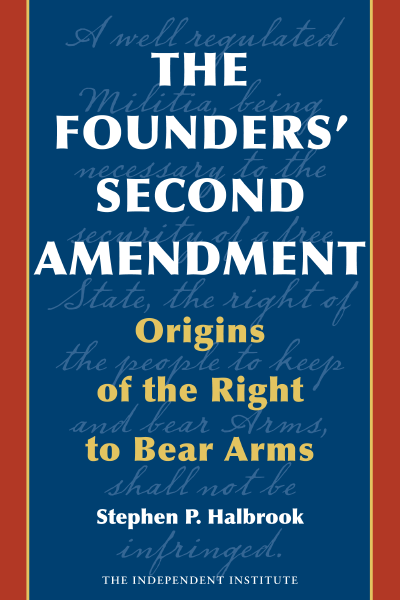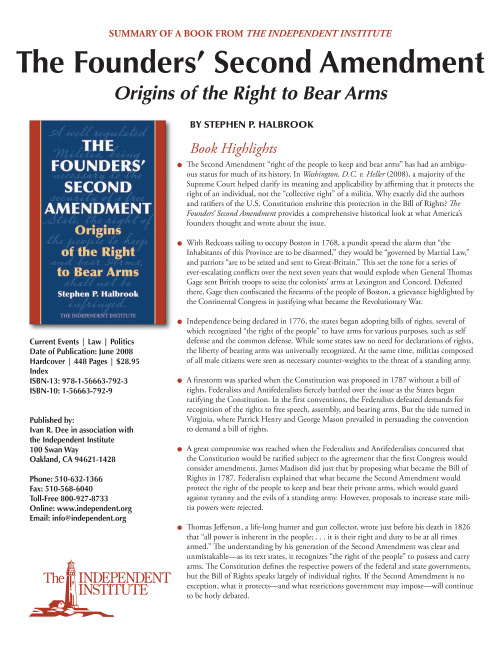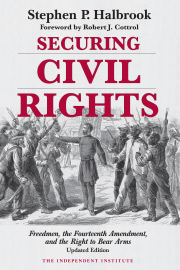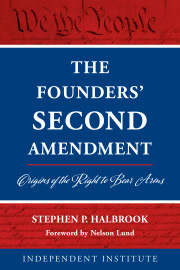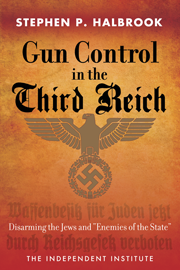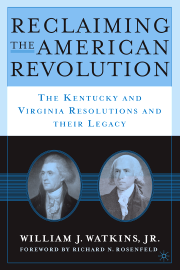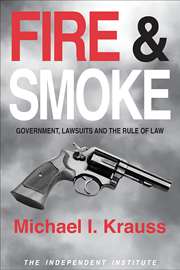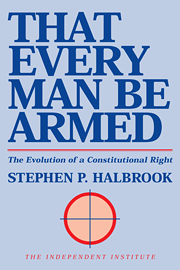| Price: | $19.95 |
| Formats |
Paperback (ISBN 978-15666-3971-2) |
Hardcover (ISBN 978-1-5666-3792-3) |
| Price: | $19.95 |
| Formats |
Paperback (ISBN 978-15666-3971-2) |
Hardcover (ISBN 978-1-5666-3792-3) |
Overview
Do Americans have a constitutional right to bear arms? Or is this power vested solely in government? Recent years have seen a sea change in scholarship on the Second Amendment. Beginning in the 1960s, a view emerged that individuals had a “right” to bear arms only in militia service—a limited, "collective" right. But in the late 1980s Dr. Stephen Halbrook and a handful of other scholars began producing an altogether persuasive analysis that changed thinking on the matter, so that today, even in canonical textbooks, bearing arms is acknowledged as an individual right.
Stephen Halbrook’s The Founders’ Second Amendment is the first book-length account of the origins of the Second Amendment, based on the Founders’ own statements as found in newspapers, correspondence, debates, and resolutions. Dr. Halbrook investigates the period from 1768 to 1826, from the last years of British rule and the American Revolution through to the adoption of the Constitution and the Bill of Rights, and the passing of the Founders’ generation. His book offers the most comprehensive analysis of the arguments behind the drafting and adoption of the Second Amendment, and the intentions of the men who created it.
With the recent U.S. Supreme Court ruling in District of Columbia vs. Heller upholding the Second Amendment as protecting an individual right to bear arms, The Founders’ Second Amendment could scarcely be more timely as the authoritative book on the subject.
Contents
Preface
Introduction
Part I: Disarming the Colonists
1. “The Inhabitants to Be Disarmed”
2. From the Tea Party to the Powder Alarm
3. The Arms Embargo and Search and Seizure at the Neck
4. A Shot Heard ‘Round the World and a “Cruel Act of Perfidy”
Part II: Of Revolution and Rights
5. “Times That Try Men’s Souls
6. “That the People Have a Right”
7. “A Musket to Defend These Rights”
Part III: The Constitution and Compromise
8. A Constitution With No Bill of Rights?
9. The “Dissent of the Minority”
10. Virginia Tips the Scales
11. “A Majority That Is Irresistible”
Part IV: “To Keep and Bear Their Private Arms”
12. Mr. Madison’s Amendments
13. The Bill of Rights in the States
14. The Great Militia Debate
15. Old Founders Never Die, They Just Fade Away
Conclusion: What Does the Second Amendment Say?
Detailed Summary
- Today, the Second Amendment to the U.S. Constitution is hotly debated. Opponents of gun laws point to the mandate that “the right of the people to keep and bear arms, shall not be infringed.” Focusing on its Militia Clause, proponents claim that the Amendment protects only State militia powers. The Founders’ Second Amendment provides a comprehensive historical look at what America’s founders thought and wrote about the issue.
- With Redcoats sailing to occupy Boston in 1768, a pundit spread the alarm that “the Inhabitants of this Province are to be disarmed,” they would be “governed by Martial Law,” and patriots “are to be seized and sent to Great-Britain.” This set the tone for a series of ever-escalating conflicts over the next seven years that would explode when General Thomas Gage sent British troops to seize the colonists’ arms at Lexington and Concord. Defeated there, Gage then confiscated the firearms of the people of Boston, a grievance highlighted by the Continental Congress in justifying what became the Revolutionary War.
- Independence being declared in 1776, the states began adopting bills of rights, several of which recognized “the right of the people” to have arms for various purposes, such as self defense and the common defense. While some states saw no need for declarations of rights, the liberty of bearing arms was universally recognized. At the same time, militias composed of all male citizens were seen as necessary counter-weights to the threat of a standing army.
- A firestorm was sparked when the Constitution was proposed in 1787 without a bill of rights. Federalists and Antifederalists fiercely battled over the issue as the States began ratifying the Constitution. In the first conventions, the Federalists defeated demands for recognition of the rights to free speech, assembly, and bearing arms. But the tide turned in Virginia, where Patrick Henry and George Mason prevailed in persuading the convention to demand a bill of rights.
- A great compromise was reached when the Federalists and Antifederalists concurred that the Constitution would be ratified subject to the agreement that the first Congress would consider amendments. James Madison did just that by proposing what became the Bill of Rights in 1787. Federalists explained that what became the Second Amendment would protect the right of the people to keep and bear their private arms, which would guard against tyranny and the evils of a standing army. However, proposals to increase state militia powers were rejected.
- Thomas Jefferson, a life-long hunter and gun collector, wrote just before his death in 1826 that “all power is inherent in the people; . . . it is their right and duty to be at all times armed.” The understanding by his generation of the Second Amendment was clear and unmistakable—as its text states, it recognizes “the right of the people” to possess and carry arms. The Constitution defines the respective powers of the federal and state governments, but the Bill of Rights speaks largely of individual rights. If the Second Amendment is no exception, what it protects—and what restrictions government may impose—will continue to be hotly debated.
The Founders of the American republic sought to guarantee “the right of the people to keep and bear arms” as a fundamental liberty. They also declared a “well regulated militia” to be necessary to secure “a free state.” Passionately discussed today in the context of the gun control controversy, the Second Amendment to the Constitution has become a controversial enigma. But what experiences led the Founders to adopt it, and what did it mean to them?
In his latest book, The Founders’ Second Amendment: Origins of the Right to Bear Arms, Stephen P. Halbrook provides perhaps the most important piece of the puzzle regarding that often-misunderstood amendment—the first truly comprehensive account of how the generation of the Founders of the American Republic viewed “the right of the people to keep and bear arms,” from the pre-Revolutionary days through the passing of that generation.
“This work seeks to present the views of the Founders who actually created the Second Amendment,” Halbrook writes in the book’s introduction. “It is based on their own words as found in newspapers, correspondence, debates and resolutions. Generous quotations from the Founders are used to allow them to speak for themselves, thereby avoiding the appearance of re-characterization of their views.”
Although The Founders’ Second Amendment answers such questions as whether the Constitution’s creators sought to guarantee an individual right or a collective right, it also shows that the Amendment’s history is interesting for reasons that go far beyond its usefulness for resolving modern legal controversies. At last, readers have a lively resource that will enable them to fully comprehend the Founders’ understanding of what is necessary to guarantee, as the Amendment itself states, “the security of a free State.”
Disarming the Colonists
Increasingly serious clashes between the colonists and the British authorities, examined in Chapters 1 to 4, led the Founders to adopt the Second Amendment. In 1768, the Redcoats began to occupy Boston and the patriots spread the alarm that, among other deprivations, the inhabitants were to be disarmed. The presence of a standing army quartered within the population led the colonists vigorously to assert their rights as Englishmen. The tragedy of the Boston Massacre only solidified the patriots’ commitment to protect themselves, by arms if need be.
From the Boston Tea Party to the Powder Alarm, repressive measures against the increasingly troublesome Americans sharply escalated. The Royalist-imposed government in Boston debated a prohibition on all private arms. General Thomas Gage’s troops seized the gunpowder in the powder houses, cutting off the supply. Searches and seizures, including alleged entrapment, were instituted against those attempting to obtain and distribute arms.
Well aware that the colonists were making every effort to arm themselves, George III sought to cut off all arms and ammunition at the source by prohibiting the export of these articles from Britain, Holland, and elsewhere and blocking their import into the colonies. This arms embargo was combined with stepped-up search-and-seizure operations in Boston.
The “shot heard ’round the world” at Lexington and Concord in 1775 involved the Redcoats’ attempted seizure of arms hoarded by militiamen and the repulse of these troops by local citizens armed with their own muskets and sporting arms. This led General Gage to impose the confiscation of all firearms from Boston’s civilians, under the promise that those in compliance could depart the besieged city. After seizing the arms “the perfidious Gage” held the townsfolk as hostages. News spread throughout the colonies.
Of Revolution and Rights
The Revolution had now been sparked. Its philosophy, as expressed in the Declaration of Independence, was that the people must endure some amount of injustice, but they may wage armed resistance when injustice becomes tyranny. The ramifications of this republican doctrine are presented in Chapter 5.
Beginning in 1776 and continuing during the War for Independence, the states took measures to provide for their own governance, as Chapters 6 and 7 detail. Virginia was the first state to adopt a declaration of rights, which included the admonition for “a well regulated Militia, composed of the Body of the People”; Pennsylvania was the first to declare that “the people have a right to bear arms for the defense of themselves, and the state.” These principles were held dear in all of the states without regard to whether they adopted a bill of rights. Skeptics deemed it unnecessary to list the many rights of mankind in a formal instrument.
The Constitution and Compromise
With independence won and rights vindicated, the next phase of the Second Amendment’s saga begins with the drafting of the Constitution at the Philadelphia convention in 1787. Its lack of a bill of rights was defended in The Federalist Papers and attacked by the Antifederalists. But both sides agreed, as explained in Chapter 8, with the ideal of an armed populace.
The proposed constitution was then considered by the state conventions, largely in 1788, as Chapter 9 explains. In the initial phase, those demanding a bill of rights protecting free speech or any other right could not muster a majority in any convention. However, the Pennsylvania Minority proposed that “the people have a right to bear arms” to defend themselves, the state, and the United States, as well as for hunting. In the Massachusetts convention, Samuel Adams proposed that “peaceable citizens” have a right to keep “their own arms.” Finally, the New Hampshire convention became the first to propose a bill of rights, including that “Congress shall never disarm any citizen” unless in rebellion.
In Virginia’s convention, Patrick Henry argued “that every man be armed,” and George Mason drafted a declaration of rights, including a guarantee of “the right of the people to keep and bear arms.” James Madison and his Federalist colleagues reached the great compromise with the Antifederalists: Virginia would ratify the Constitution without a bill of rights, but would propose one and urge its prompt adoption. How Virginia tipped the scale in favor of a declaration of rights is described in Chapter 10.
In the remaining state conventions, the majority in favor of a bill of rights had become irresistible. New York demanded one, and North Carolina refused to ratify the Constitution until a bill of rights had been introduced in Congress. Chapter 11 explains these developments, which included significant mention of the right to bear arms.
“To Keep and Bear Their Private Arms”
James Madison lived up to his promise and introduced what became the Bill of Rights in the first session of Congress in 1789. The Second Amendment was interpreted, as Federalist Tench Coxe expressed it, to guarantee the right of the people to keep and bear “their private arms.” The Senate rejected restricting the right to bear arms to “the common defense” and also rejected a proposed state power to maintain a militia. These developments are described in Chapter 12.
The proposed Bill of Rights was then considered for adoption by the states. No record exists of any criticism of “the right of the people to keep and bear arms,” although the militia clause was taken to task for not actually doing anything. The Bill of Rights, as explained in Chapter 13, was finally adopted in 1791.
Meanwhile, the nature of a well-regulated militia was debated in Congress. The Militia Act of 1792 would require that all able-bodied white males enroll in the militia and provide their own arms. Both the power of the states to maintain militias and the right of individuals to have arms for self-defense, as Chapter 14 shows, were considered basic.
The first commentary on the Constitution, by St. George Tucker, posited that the Second Amendment protects individual rights and that legislative infringement was subject to judicial review. George Washington, John Adams, and Thomas Jefferson exposited and exercised the right to bear arms. James Madison, writing in his final years, reaffirmed his association of republican government with an armed populace.
What Does the Second Amendment Say?
The book concludes with a linguistic analysis as informed by the Founders’ usage of terms. The terms “right of the people” as used in the First, Second, and Fourth Amendments are contrasted with such phrases as “the militia, when in actual service” in the Fifth Amendment and with the powers “reserved to the states respectively” in the Tenth Amendment.
A lively debate has erupted in recent times on the meaning of the Second Amendment. Under the “collective rights” view, the Amendment protects state powers to maintain militias, not an individual to keep and bear arms. A hybrid version argues that it protects a “civic right” to bear arms in the militia. The historical evidence set forth in this book, however, suggests that the Founders had a predilection for both a well-regulated militia and an individual right to have arms, and that they envisioned that the two clauses of the Amendment would complement rather than be in tension with each other.
Praise
“Stephen Halbrook’s The Founders’ Second Amendment is first-rate work, utterly convincing. This is a solid and important work.”
—FORREST McDONALD, Distinguished Research Professor Emeritus of History, University of Alabama
“I enthusiastically recommend Stephen Halbrook’s book, The Founder’s Second Amendment. This is an original and valuable approach, focusing on the place of individual ownership of firearms during the time of the American Revolution and the drafting and ratification of the Constitution and Bill of Rights. It will add appreciably to the scholarship on the origins and meaning of the Second Amendment.”
—JOYCE L. MALCOLM, Professor of Legal History, George Mason University School of Law
“Halbrook delves deeply into the importance of firearms during the Revolution, finding that attempts by search-and-seizure to control the flow of guns was regarded as the typical tyrannical behavior of a standing army. Liberty hinged on free ownership. . . . his book should be welcomed as a timely introduction to this most contentious of debates."
—PUBLISHERS WEEKLY
“The subject of The Founders’ Second Amendment is currently ‘front-and-center’ as a ‘hot’ and major controversy. Well researched and well presented, Halbrook’s book has brought forward a substantial amount of new research, not redundant of what others have provided, and this book will find a solid place among leading works on the subject.”
—WILLIAM W. VAN ALSTYNE, Lee Professor of Law, College of William and Mary
“The Founder’s Second Amendment is an impressive achievement. Halbrook shows conclusively to any honest mind, both in respect to historical evidence and analytical jurisprudence, that the Framers intended the Second Amendment not as the reserved right of a State government to organize a militia, but of the people as individuals to keep and to bear arms. In this meticulously researched and exhaustive study, Halbrook has produced what promises to be the standard work for years to come on the original intent of the Second Amendment. It will be an invaluable resource for scholars of the Constitution.”
—DONALD W. LIVINGSTON, Professor of Philosophy, Emory University
“Stephen Halbrook’s The Founders’ Second Amendment is crisply written, rich with history, and sure to be valuable to anyone interested in understanding the original meaning of the Second Amendment’s right to bear arms.”
—GLENN HARLAN REYNOLDS, Beauchamp Brogan Distinguished Professor of Law, University of Tennessee
“Like much of Halbrook’s other excellent work, The Founders’ Second Amendment is both well-written and full of fascinating details. It will serve as an important resource for professional scholars and interested laypersons. One especially useful aspect of Halbrook’s work is that the author so consistently lets a huge variety of original sources speak for themselves.”
—NELSON LUND, Patrick Henry Professor of Constitutional Law, George Mason University
“The Founders’ Second Amendment: Origins of the Right to Bear Arms: Halbrook is a well-published scholar who has written a timely, well-informed, lucid book on the ‘origins of the right to bear arms.’ He covers the Second Amendment’s historical underpinnings from 1768-1826, and so offers readers a rich interpretive framework from which to grasp the U.S. Supreme Court’s (conservative) decision in June 2008, which was handed down after the book’s publication. The decision affirms the constitutional right of individuals to keep guns at home for self-defense, and prohibits government from violating said right. (That is, the Court struck down the District of Columbia’s ban on individual ownership of handguns.) In brief, Halbrook explores why he believes the ‘original intent’ of the framers was to underscore a personal, and not merely a militia-based, collective right to bear arms. Given his interpretation that only individual persons have substantial rights, whereas it is states that possess ‘powers’ in the requisite sense, it is not unexpected that the author’s argument supports the Supreme Court’s subsequent decision. Recommended. Suitable for educated readers, all levels.”
—CHOICE
“Historian and philosopher Stephen Halbrook is the single most prolific researcher on the Second Amendment, having contributed literally dozens of scholarly articles on various aspects of the subject. The Founders’ Second Amendment masterfully both extends and summarizes his (and others’) research. It is the last word—the single most comprehensive work on the thinking of the Founding Fathers’ era about the constitutional right of citizens to be armed.”
—DON B. KATES, JR., author, Armed: New Perspectives on Gun Control and The Great American Gun Debate (with Gary Kleck)
“Stephen P. Halbrook is a giant among Second Amendment scholars. As the Supreme Court’s recent decision in District of Columbia v. Heller vividly illustrates, the smug dismissal of the Second Amendment’s importance is no longer tenable. For the first time in our history, the Supreme Court has found that a gun-control statute violated the Second Amendment, and it did so largely on the basis of the kind of original-meaning historical analysis that Halbrook pioneered. Nobody has been more persistent or more prolific than Halbrook in the long intellectual campaign that made this victory possible. Whatever may happen in future litigation, Halbrook deserves the gratitude of everyone who thinks that the Constitution deserves to be taken seriously as law. . . . Halbrook has now produced a book that only he could have written. The Founders’ Second Amendment is a comprehensive study of the legislative history of this quintessentially American constitutional provision. Aimed at both a general and a professional audience, Halbrook’s work has several valuable qualities that are often absent from modern legal and historical scholarship. First, it is highly readable. Anyone who has been called on to explain the genesis of a law knows how difficult it can be to combine completeness with clarity. Halbrook has not only succeeded in this difficult task, he has made the story interesting as well. The volume doesn’t stop with the usual materials of a legislative history—i.e., general background, legislative debates, and public commentary by prominent participants in the process. Halbrook seems to have read everything ever written by or about the people who were involved in the story he tells, including obscure records and pamphlets as well as private letters and diaries. . . . Finally, Halbrook is not afraid to quote liberally from the documents on which he relies. . . . Halbrook lets the actors in his story speak for themselves, and the reader is free to conclude that his interpretation of what they said is questionable or even wrong. . . . Neither we nor our courts will find all the answers we need in the history that Halbrook presents so well. But this is the place to start looking, because some very important preliminary questions are indeed answered here. Every American who cares about this provision of the Constitution can now arm himself against the sophistries and oversimplifications that have permeated much of the popular and professional discourse about the origins of the Second Amendment. Doing so would be a fitting tribute to those who set us on a road to freedom at Lexington and Concord.”
—NATIONAL REVIEW
“The Founders' Second Amendment: Origins of the Right to Bear Arms considers the history of the constitutional rights of Americans to bear arms in early America from 1768 to 1826, offering up the first book-length account of these origins based on the Founders' own statements from newspapers, debates, and legislative resolutions. The depth and detail added to source material quotes makes this a fine pick for both college and high school collections strong in American history and politics.”
—MIDWEST BOOK REVIEW
“Stephen P. Halbrook’s new book represents the most careful and well-thought-out study yet in support of the politically ascendant claim that the Second Amendment, as originally intended and understood, protects a right to own guns for purposes other than service in the lawful militia. It far surpasses Justice Antonin Scalia’s historically naıve analysis in District of Columbia v. Heller, the 2008 Supreme Court decision that first recognized a constitutional right to weapons possession for hunting and self-defense. Halbrook’s latest work is exhaustive in scope. He reviews dozens of documents (many of them previously ignored) that can quite plausibly be read to support an original understanding of a right that extends far beyond what was required to ensure the people’s capacity to serve in the militia. . . . Halbrook has clearly immersed himself deeply in the primary record of the constitution making process on the state and federal levels. His analysis of Justice James Wilson’s law lectures in Philadelphia, St. George Tucker’s Blackstone’s Commentaries, and post-ratification state constitutional reform in the early 1790s do support (but not irrefutably so) the claim that for some contemporary readers, more was at stake in the Second Amendment than preservation of the militia. . . . Halbrook concedes much more than other gun rights advocates respecting the meaning of the right to arms. He acknowledges that the principal evil that the framers of the Second Amendment aimed to prevent was the disarming of the militia that would invite creation of a standing army. He even allows that the militia of the framers has long since gone away. . . . As Halbrook concludes, “the experiences of the American Revolution proved the right to keep and bear arms serves as the ultimate check that the founders hoped would dissuade persons at the helm of state from seeking to establish tyranny. In hindsight, it would be difficult to quarrel with the success of the founders’ vision” (p. 338). It seems to me one could quarrel with the success of that vision on at least two levels. Realizing that the American War was fought as much over taxes as over guns, one might ask whether objections to readily affordable taxes on tea imposed by a government whose legitimacy nobody had questioned until a decade before justified a resort to arms, seven years of war, 40,000 dead, and 100,000 refugees. One could also argue that precisely those dangers which animated the framers of the Second Amendment have now been willingly embraced by the governmental agents of the American people, and that we confront the very ruin the framers prophesized. We have an enormous standing army we cannot afford, and with it foreign military adventures and two wars looking suspiciously like wars of imperialism. We have lost our virtue, and become slaves to deficit spending and heavy taxes, and a client dependent on foreign interests to finance our martial folly. To the framers of the Second Amendment, these would have been grounds for lamentation, not celebration.”
—AMERICAN HISTORICAL REVIEW
“Halbrook’s approach is to discover the answer to the question of what did the Amendment ‘mean to the Founders?’ . . . Halbrook’s book covers the relevant history from 1768 until the 1820’s. He presents much strong historical evidence that supports the individual rights approach. . . . Halbrook covers the fundamentals and this book remains as timely as ever. . . . this is an impressive and thoroughly researched and documented work. It is one the best scholarly books available on the topic. Of course, for many readers, this book is no longer the definitive exposition of originalism and the individual rights model. Justice Scalia’s majority opinion in Heller has succeeded it. On the other hand, this book is much more readable than a U.S. Supreme Court opinion.”
—LAW AND POLITICS BOOK REVIEW, American Political Science Association
“Stephen P. Halbrook’s The Founders’ Second Amendment: Origins of the Right to Bear Arms is a history lesson in freedom. The book should be considered required reading for Americans who want a better understanding of how our Founders viewed gun rights and why they protected such rights with an amendment to the Constitution. . . . Through the pages of The Founders’ Second Amendment readers see that the right to keep and bear arms was integral to the worldview of those who fought for this nation and framed its Constitution. And because of the importance of that right—and the fact that it existed before the United States was even a dream in the mind of Jefferson—readers recognize our Founders’ special challenge was protecting the right from the machinations of the very government set forth in the Constitution. The Second Amendment is a bulwark for freedom.”
—BREITBART NEWS
Author
Dr. Stephen P. Halbrook is a Research Fellow at the Independent Institute. Dr. Halbrook received his J.D. from the Georgetown University Law Center and Ph.D. in social philosophy from Florida State University, and he has taught legal and political philosophy at George Mason University, Howard University, and Tuskegee Institute. His many books also include That Every Man Be Armed: Evolution of a Constitutional Right.
News
Events
| Event | Date | |
| Sr. Fellow Stephen Halbrook, author of The Founders’ Second Amendment and Securing Civil Rights speaks at The Federalist Society in Washington, DC on Tuesday, January 15, 2019 | Tue., Jan. 15, 2019 | |
| Senior Fellow Stephen Halbrook speaks at the conference, “The Second Amendment: Its Meaning and Implications for Modern America,” Duncan School of Law, Lincoln Memorial University | Thu., Jan. 18, 2018 |

